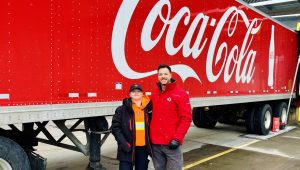An Ottawa startup has secured $1.6 million in seed funding to develop its groundbreaking technology that is designed to remove carbon dioxide from extremely cold air – a process the firm’s founders say is more efficient and less expensive than current methods of capturing carbon.
Founded in 2020 by chemical engineers Vida Gabriel and Sean Wilson, TerraFixing was recently named one of the top 100 most promising ventures competing in XPRIZE Carbon Removal, a US$100-million, multi-year global competition sponsored by Tesla founder Elon Musk and his foundation.
Previously funded mainly through sweat equity and government grants, the startup based out of Bayview Yards now has the backing of Quebec-based Tugliq Énergie Co., which generates wind and solar power at various sites around the world.
(Sponsored)

Family-owned Coke Canada Bottling investing to grow in Ottawa-Gatineau
Have you ever wondered where your favourite Coca-Cola products come from? Few people in know that over 300 popular beverages products, like Coca-Cola, Coke Zero, Fuze, Fanta, Monster Energy, A&W

DYMON and The Ottawa Mission celebrate record-breaking Giving Tuesday success
The Ottawa Mission is celebrating a historic Giving Tuesday after raising more than $1.1 million in support of people experiencing homelessness, hunger, and poverty — the most successful Giving Tuesday
In addition to the seed capital, the deal finalized earlier this month also includes a commercial agreement that will see Tugliq invest up to $10 million in the Ottawa venture to help it build two carbon-capture units that will be deployed in Northern Canada.
TerraFixing’s founders say they’ve devised the only process in the world that can effectively capture carbon directly from the air in cold climates such as Canada’s North. The company says the system can operate efficiently in temperatures below freezing, using renewable wind energy to power its solution while taking advantage of the natural benefits of extracting carbon dioxide where the atmosphere is more frigid.
“It’s thermodynamically more favourable to (capture carbon) in cold climates than warm climates,” explains Wilson, who earned a PhD in chemical engineering at the University of Ottawa in 2020 and has been researching carbon-capture technology for more than a decade.
“If our aim is to create a direct air capture (system) that’s going to be the most economical, then doing it in cold climates is the better idea.”
Wilson said the company hopes to launch its first unit – which will be slightly larger than a 20-foot shipping container and designed to capture 1,000 tons of carbon a year – within the next 12 months at a mine at Fermont, Que., near the border with Labrador.
TerraFixing then plans to install a second unit in the North that will be twice the size of its initial model and capable of capturing four times as much carbon.
“The key to a low-carbon world is the North and deploying there,” Wilson says. “There’s optimal conditions in terms of the cold weather and it’s windy. For us to co-deploy both direct air capture and wind energy assets in these areas … aligns very heavily with our mission.”
TerraFixing’s system uses powerful fans to push air through two absorbent beds. The first bed extracts water from the air, while the second contains a highly absorbent, proprietary material developed by the company’s engineers that captures CO2 from the dehumidified air.
The CO2-saturated bed is vacuumed to remove impurities before being heated to release the pure carbon dioxide. The CO2 is then compressed and sequestered in underground areas such as mines, where it reacts with minerals in the rocks to form calcium or magnesium carbonate.
Because air circulates so freely, Wilson said it will be possible for the technology to capture carbon dioxide generated thousands of kilometres away.
He envisions a day when hundreds or even thousands of the units will be deployed at “three or four main hubs” in remote northern areas that could have the ability to capture CO2 from all over the world.
“You’ll be catching CO2 in Northern Canada from someone breathing out in South America,” he explains. “That’s how dispersed it is.”
Expanded R&D lab
Now at eight employees, TerraFixing plans to use the new seed funding to hire more scientists and expand its R&D laboratory at uOttawa. Its scaleup drive comes amid a surge of interest in the carbon capture space.
As record-breaking heat waves and other dramatic weather events related to climate change such as wildfires continue to dominate headlines, the push to find new ways of scrubbing CO2 from the atmosphere is ramping up.
TerraFixing is one of a myriad of enterprises vying for a piece of what the U.S.-based Global CO2 Initiative predicts could be a US$800-billion market by 2030. In Ottawa alone, a number of other companies – including Hyperion Global Energy and Planetary Technologies – are working on their own solutions for removing carbon dioxide from the air and safely storing or reusing it.
Even if the labour market isn’t exactly flooded with engineers who are well-versed in carbon-capture technologies, Wilson said he’s not worried about finding enough skilled workers to round out his team.
“No one else is trying to do what we’re trying to do,” he says. “I don’t think other people are trying to look at the same sources of talent as we are.”
And while many tech entrepreneurs dream of building organizations that will stand the test of time to become “100-year companies,” Wilson’s ambitions are different. He’s longing for the day when greenhouse gas emissions no longer threaten the planet and his venture’s technology will become obsolete.
“Nothing would almost make me happier than if in 40 years’ time TerraFixing was so successful that we put ourselves out of business,” he says. “That’s the dream.”




